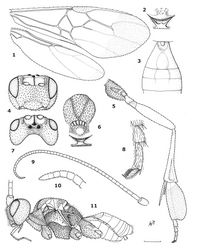Hartemita khuatbaolinhae
| Notice: | This page is derived from the original publication listed below, whose author(s) should always be credited. Further contributors may edit and improve the content of this page and, consequently, need to be credited as well (see page history). Any assessment of factual correctness requires a careful review of the original article as well as of subsequent contributions.
If you are uncertain whether your planned contribution is correct or not, we suggest that you use the associated discussion page instead of editing the page directly. This page should be cited as follows (rationale):
Citation formats to copy and paste
BibTeX: @article{Long2011ZooKeys102, RIS/ Endnote: TY - JOUR Wikipedia/ Citizendium: <ref name="Long2011ZooKeys102">{{Citation See also the citation download page at the journal. |
Ordo: Hymenoptera
Familia: Braconidae
Genus: Hartemita
Name
Hartemita khuatbaolinhae Long & van Achterberg, 2011 sp. n. – Wikispecies link – ZooBank link – Pensoft Profile
Type material
Holotype, female (IEBR), “Card.001”, “[NE Vietnam:] Phu Tho, Xuan Son NP, forest, 10.v.2005, P. Th. Nhi.” Paratypes: 1 female (RMNH), “Card.002”, data as holotype; 1 female (IEBR), “Card.010”, “[CN Vietnam:] Ha Tinh, Huong Son, Son Hong, 23.iv.2004, Tr. X. Lam”.
Diagnosis
The new species is similar to Hartemita muirii (Fullaway), but differs by having the face rugose-punctate (punctate in Hartemita muirii; Fig. 4), temples bulging (subparallel-sided in Hartemita muirii; Fig. 7), hind basitarsus largely yellow (largely blackish in Hartemita muirii; Fig. 5) and the hind claw with 5 teeth (8 teeth in Hartemita muirii; Fig. 8).
Description
Holotype, female, body length 7.7 mm, fore wing length 8.2 mm, antenna 9.5 mm.
Head. Antennal segments 52 (paratype: 51); third antennal segment 1.3 times fourth segment; length of third, fourth and penultimate segments 2.1, 1.6 and 1.6 times their width, respectively; eye glabrous, twice as long as its lateral width; width of face 1.5 times as long as height of eye; clypeal margin convex medio-ventrally (Fig. 23); epistomal suture distinct and evenly curved; malar space 1.2 times basal width of mandible (Fig. 23); in dorsal view head transverse, its width nearly twice as long as its median length; occiput deeply excavate (Fig. 24); temple behind eyes convex anteriorly and roundly narrowed posteriorly; length of temple 1.2 times transverse diameter of eye (Fig. 24); width of eye 0.55 times temple laterally; OOL:POL:OD= 15:9:6; face rugose-punctate; clypeus largely punctate; frons smooth and with a median carina; area around ocelli with transverse and dense rugae; temple largely rugose ventrally and with large punctures dorsally.
Mesosoma. Length of mesosoma 1.3 times its height; pronotal trough rugose dorsally, remainder of pronotal side smooth; notauli deep and areolate posteriorly; scutellar sulcus with 6 cross-carinae (paratype with 5); scutellum convex and punctate; mesoscutum rugose-punctate; median arch of metanotum with short lateral cross-carinae (Fig. 26); mesopleuron smooth medially and rugose-punctate anteriorly; precoxal sulcus shallow; mesosternum rugose-punctate; metapleuron and propodeum rugose.
Wings. Length of fore wing 2.3 times its maximum width; length of pterostigma 4.3 times its median width; r:2-SR:3-SR = 16:26:53; length of second submarginal cell of fore wing 3.2 times its maximum width; vein 1-SR+M slightly sinuate (Fig. 25); vein 1-CU1 0.5 times vein 2-CU1 (10:22); vein 3-SR joining SR1 at 90°. Length of hind wing 4.6 times its width; vein M+CU 0.3 times as long as vein 1-M.
Legs. Length of hind femur 4.25 times its median width; hind basitarsus broadly laminate, slightly produced apically and 2.1 times as long as wide (Fig. 28); width of hind basitarsus 1.4 times apical width of hind tibia; second-fifth hind tarsal segments 0.6 times as long as hind basitarsus (Fig. 28); inner hind tibial spur 0.6 times as long as hind basitarsus; hind claw with 5 teeth (Fig. 27).
Metasoma. Metasoma as long as mesosoma; second metasomal tergite 0.85 times as long as third tergite; ovipositor sheath very short, round apically; ovipositor almost straight.
Colour. Body yellow; antenna dark brown; scapus yellow, but apex and outer side dark brown; frons and stemmaticum black; vertex yellow anteriorly and black posteriorly; temple partly black dorsally; median and lateral lobes of mesoscutum and mesosternum black; middle trochantellus, apical upper and lower sides of hind coxa, hind trochanter apically, hind trochantellus, apical third of basitarsus and hind tarsus (except basitarsus) black; fore wing brown, but smoky apically.
Male. Unknown.
Distribution
N Vietnam: Phu Tho and C Vietnam: Ha Tinh.
Etymology
The species named after the granddaughter of the first author, Khuat Bao Linh.
Original Description
- Long, K; van Achterberg, C; 2011: Review of the genus Hartemita Cameron, 1910 (Hymenoptera, Braconidae, Cardiochilinae), with the description of six new species from Vietnam ZooKeys, 102: 19-46. doi
Images
|

